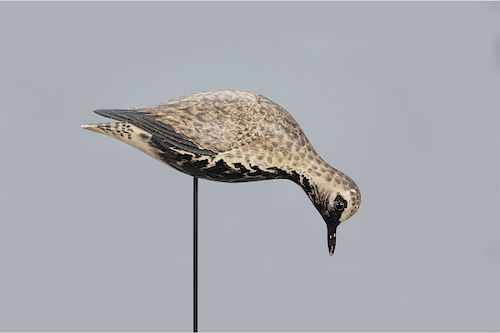The Harmon Feeding "Dust Jacket" Plover Decoy, A. Elmer Crowell (1862-1952)
Lot 275B
About Seller
Copley Fine Art Auctions
20 Winter Street
Pembroke, MA 02359
United States
Founded in 2005, Copley Fine Art Auctions is a boutique auction house specializing in antique decoys and American, sporting, and wildlife paintings. Over the course of the last two decades, the firm has set auction records for not only individual decoy makers, but also entire carving regions. Copley...Read more
Estimate:
$300,000 - $500,000
Absentee vs Live bid
Two ways to bid:
- Leave a max absentee bid and the platform will bid on your behalf up to your maximum bid during the live auction.
- Bid live during the auction and your bids will be submitted real-time to the auctioneer.
Bid Increments
| Price | Bid Increment |
|---|---|
| $0 | $50 |
| $1,000 | $100 |
| $2,500 | $250 |
| $5,000 | $500 |
| $10,000 | $1,000 |
| $25,000 | $2,500 |
| $50,000 | $5,000 |
About Auction
By Copley Fine Art Auctions
Jul 25, 2019
Set Reminder
2019-07-25 10:00:00
2019-07-25 10:00:00
America/New_York
Bidsquare
Bidsquare : The Sporting Sale 2019
https://www.bidsquare.com/auctions/copley/the-sporting-sale-2019-4227
July 25 at 10 am | 550 lots Copley Fine Art Auctions cinnie@copleyart.com
July 25 at 10 am | 550 lots Copley Fine Art Auctions cinnie@copleyart.com
- Lot Description
A. Elmer Crowell (1862-1952)
East Harwich, MA, c. 1910
11 in. long
The Crowell feeding black-bellied plover form is among the most popular in all of decoy collecting. Mackey’s American Bird Decoys and Delph’s New England Decoys each feature a feeder, and the fourth known example of this esteemed group resides in the The Paul Tudor Jones Collection. The Jones decoy set the world record for any shorebird decoy, selling at auction for $830,000. The Harmon example differentiates itself from the Mackey, Delph, and Jones examples with its head canted to the left. This Harmon feeding plover and the Jones example are regarded as the top two feeders.
Crowell captures this rare pose perfectly, demonstrating his familiarity with the species. The arched back extends to a tapered neck and round head that is engaged with the space below it, suggesting the pulling of a morsel from the flats. True to the pose, the wing tips and tail are drawn together more closely, in contrast to the splayed tails of its rigmates. The incised primaries extend six inches in length along the lower edges of the wings and continue up the birds back where they resolve with a pronounced hollow between the two wings.
Crowell’s exquisite paint techniques laid atop the masterful sculpture create an illusion of realism unrivaled by any other decoy maker. The bird’s surface is finished with Crowell’s best high-contrast marbleized paint along the lower sides with the back showcasing his signature wet-on-wet paint throughout the mottled feather groups. The underside of the tail is cold-stamped “C. W. LOUD.”
Outstanding original paint with minimal gunning wear
Provenance: C. W. Loud Rig
Seymour Rapaport Collection
Ted and Judy Harmon Collection, acquired from the above, c. 1977
Literature: Brian Cullity, “The Songless Aviary: The World of A. E. Crowell & Son,” Hyannis, MA, 1992, p. 49, pl. II, and p. 59, exact decoy illustrated.
Robert Shaw, "Bird Decoys of North America," New York, NY, 2010, p. 160, exact decoy illustrated.
John Clayton, “Massachusetts Masters: Decoys, Shorebirds, and Decorative Carvings” The Ward Museum of Wildfowl Art, Salisbury University, 2010, p. 86, exact decoy illustrated.
Frank Maresca & Roger Ricco, "American Vernacular," New York, NY, 2002, p. 32, exact decoy illustrated.
Joe Engers, ed., "The Great Book of Wildfowl Decoys," San Diego, CA, 1990, p. 53, exact decoy illustrated.
William J. Mackey Jr., "American Bird Decoys," New York, NY, 1965, p. 64, pl. III, and dust jacket, related plover illustrated.
John and Shirley Delph, "New England Decoys," Exton, PA, 1990, dust jacket, related plover illustrated.
Loy S. Harrell Jr., "Decoys: North America’s One Hundred Greatest," Iola, WI, 2000, p. 98, related plover illustrated.
Stephen B. O'Brien Jr. and Chelsie W. Olney, "Elmer Crowell: Father of American Bird Carving," Hingham, MA, 2019, p. 305, exact decoy illustrated.
Exhibited: Salem, Massachusetts, “Tollers and Tattlers: Massachusetts Waterfowl Decoys, 1840s–1940s,” Peabody Museum of Salem, October 19, 1989–1992
Sandwich, Massachusetts, “The Songless Aviary: The World of A. E. Crowell & Son,” Heritage Plantation of Sandwich, May 10–October 25, 1992.
Canton, Massachusetts, “A. Elmer Crowell: Master of Decoys and More,” Museum of American Bird Art at Mass Audubon, September 27, 2008–May 10, 2009.
Salisbury, Maryland, “Massachusetts Masters: Decoys, Shorebirds and Decorative Carvings,” Ward Museum of Wildfowl Art, Salisbury University, LeMay Gallery, October 1, 2010–January 23, 2011.
Peoria, Illinois, “American Decoy: The Invention,” Peoria Riverfront Museum, February 9–April 28, 2019.Please email condition report requests to colin@copleyart.com. Any condition statement given is a courtesy to customers, Copley will not be held responsible for any errors or omissions. The absence of a condition statement does not imply that the lot is in perfect condition.Condition
- Shipping Info
-
Shipping info
Copley Fine Art Auctions does not handle the shipping of any items. Shipping is the sole responsibility of the buyer. Once your payment has cleared, and we have received your authorized shipping release form items may be released for shipment. Copley Fine Art Auctions, LLC shall have no liability for any loss or damage to such items. Buyers should allow up to four weeks for shipment.Please be aware that internet bidders may NOT not pick up their items at the sale. Items will be available for pick up by appointment or by shippers five days after the sale.
-



 EUR
EUR CAD
CAD AUD
AUD GBP
GBP MXN
MXN HKD
HKD CNY
CNY MYR
MYR SEK
SEK SGD
SGD CHF
CHF THB
THB














